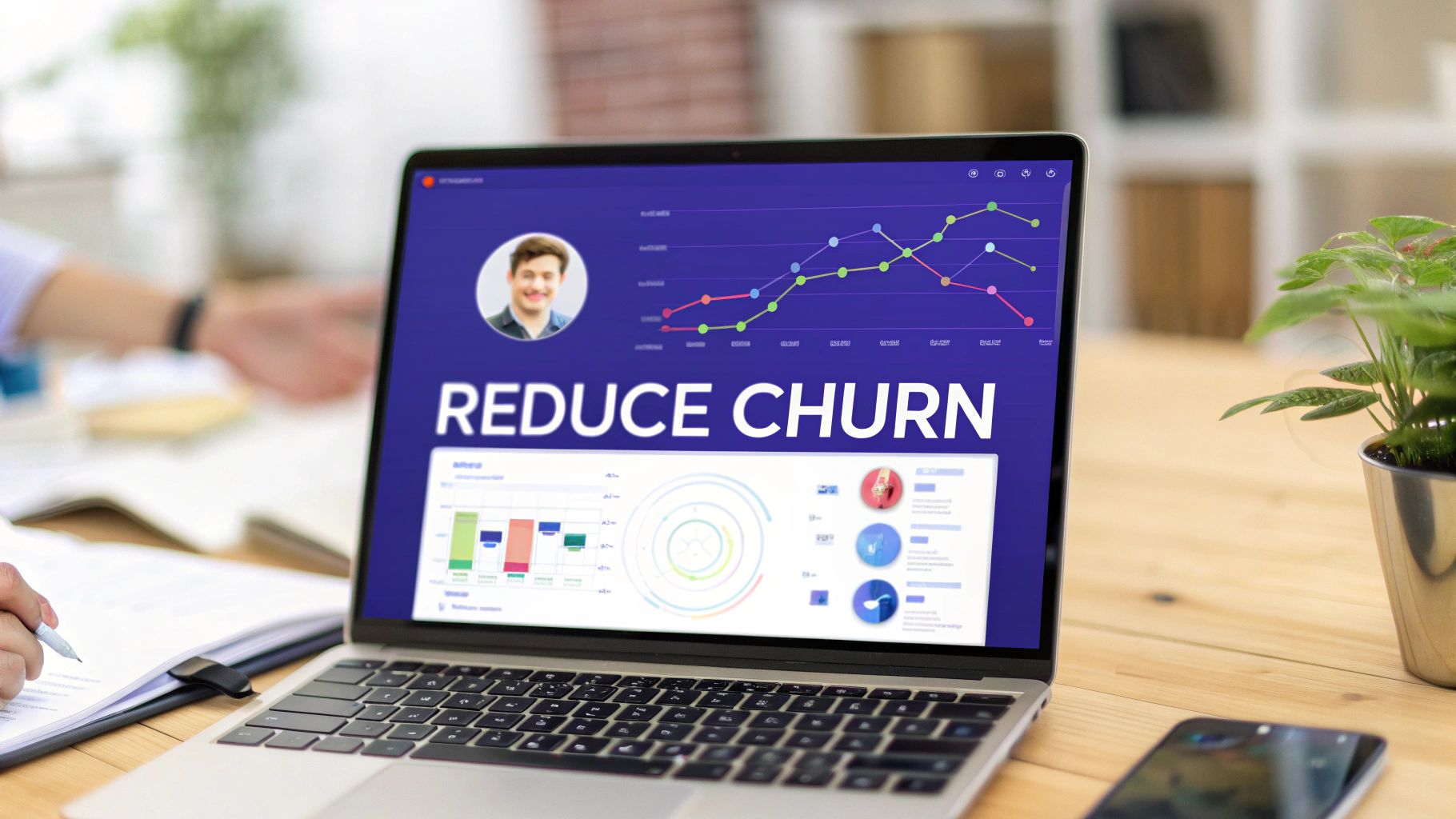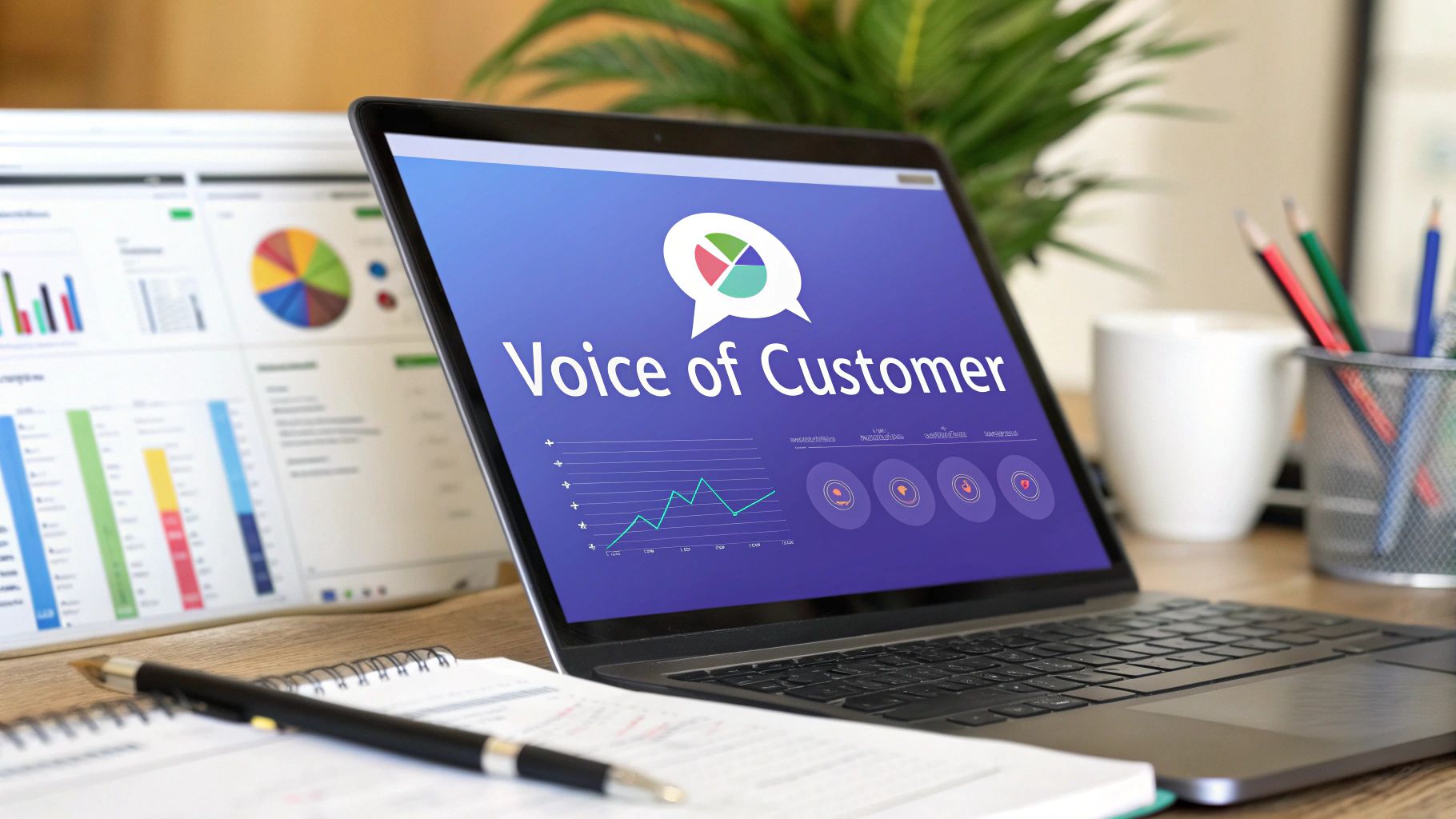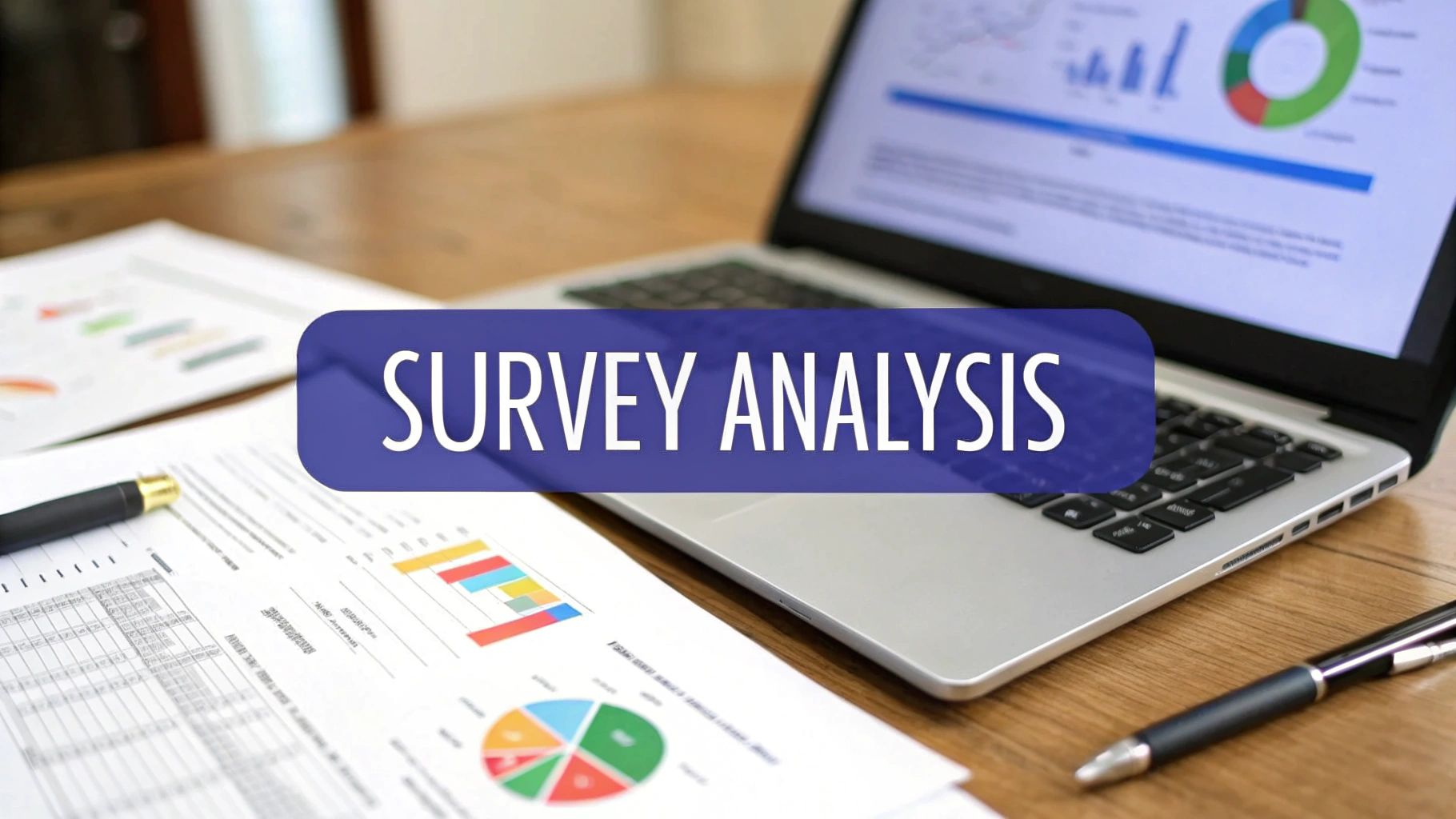A Practical Guide to Reducing Customer Churn
Discover proven strategies for reducing customer churn. This guide offers actionable steps to analyze churn, gather feedback, and improve retention.

Reducing customer churn is about figuring out why customers are leaving. The real goal is to improve customer retention by improving your onboarding, consistently gathering feedback, and making sure you are delivering real value.
This is a smarter (and cheaper) strategy than constantly scrambling to acquire new customers just to replace the ones walking out the door.
The True Cost of a Leaky Customer Bucket
Losing customers is expensive. Most SaaS leaders seriously underestimate the real financial damage. Churn is often treated as another metric on a dashboard, a necessary cost of doing business. This view misses the snowball effect that even a tiny churn rate can have on long-term growth and profitability.
Think of your customer base as a bucket you’re trying to fill. Your acquisition efforts are the faucet, pouring new customers in. Churn is the leak at the bottom. A small leak might not seem like a big deal at first, but over time, you’ll find yourself opening the faucet wider just to keep the water level from dropping.
Why Small Leaks Cause Big Problems
That "small" monthly churn rate can quickly become a massive revenue problem. For example, a monthly churn of 5% might not sound alarming, but it compounds to an annual customer loss of nearly 46%. That means you're forced to replace almost half of your customer base every year just to break even.
Let's put that into perspective.
How Monthly Churn Compounds Annually
It's shocking how quickly small monthly losses add up over a year. This table shows the real impact.
As you can see, monthly churn rates hitting 10% or more can lead to annual losses exceeding 70%. That's a situation that threatens the survival of most businesses. This constant treadmill of replacing lost customers directly sabotages your sales and marketing spend. Every dollar you spend acquiring a new user is wasted when another one is quietly slipping away.
The Impact on Growth and Value
High churn drains your current revenue and poisons your company's future value. It tanks your Customer Lifetime Value (CLTV), a metric that investors and stakeholders scrutinize. When customers leave too soon, they never get a chance to upgrade, expand their usage, or become the loyal advocates who drive organic growth.
Our guide on how to calculate CLTV offers a better look into why this metric is so important.
Reducing customer churn is a defensive play to protect revenue and a powerful driver of sustainable growth. It should be a top priority for any SaaS leader who is serious about building a lasting business.
Ultimately, tackling churn head-on transforms your business. You move from a frantic scramble for new logos to building a stable foundation of loyal, high-value relationships. This is the shift that separates the companies that merely survive from the ones that thrive.
Finding the Real Reasons Customers Leave
Guessing why customers cancel is a losing game. You might assume your pricing is the problem, but it could be a clunky feature that’s driving everyone crazy. If you want to build a retention strategy that works, you have to stop assuming and start digging for real answers.
Any solid plan to reduce churn starts with a proper diagnosis. Before you can think about a fix, you need to know the problem. That means looking at both what your customers do and what they say.
Uncovering Clues in User Behavior
Your product usage data is a goldmine. It tells a story about how engaged, successful, or frustrated your customers are. Looking into this data is how you spot the patterns that pop up right before someone cancels.
Look for the leading indicators of churn by tracking what users are doing inside your product. These small shifts in behavior are often the earliest warning signs that a customer is drifting away.
Here are a few common red flags to watch for:
- A sudden drop in logins: If a daily active user suddenly starts logging in once a week, something’s up.
- Decreased feature usage: Are they ignoring the core features that once made your product a must-have? That’s a huge sign that they’re not seeing the value anymore.
- Fewer support tickets: This might sound like a good thing, but a sudden silence from a previously vocal customer can mean they’ve simply given up trying to solve their problems.
By tracking these kinds of behavioral metrics, you can create a "customer health score." This score helps you proactively flag at-risk accounts before they think about canceling, giving your success team a chance to step in and help.
Asking the Right Questions with Exit Surveys
While user behavior shows you what is happening, exit surveys are how you find out why. A well-designed cancellation survey is one of the most direct ways to get brutally honest feedback about where your product is falling short. The key is to make it easy for departing customers to tell you what went wrong.
Keep your surveys short. A simple multiple-choice question with an open-ended "Other" option is usually your best bet. This lets you neatly categorize the feedback while still capturing unique, detailed insights you wouldn't get otherwise.
Common Churn Reasons to Track
Your exit survey should help you pinpoint the exact reason for the cancellation. Once you start grouping that feedback into clear categories, you can begin to spot powerful trends.
This foundation of data, both behavioral and self-reported, is what you'll build your entire retention strategy on. It’s what moves you from panicking every time a customer leaves to proactively solving the problems that cause churn. Once you have a clear diagnosis, you can finally start implementing targeted solutions that make a real difference.
Using Customer Feedback to Proactively Prevent Churn
If you're only reacting to churn, you're always one step behind. Getting ahead of it is the key. This means building a system that listens to what your users are telling you, both directly and through their actions.
It’s all about monitoring your feedback channels to spot the early warning signs and smooth out friction before it becomes a cancellation request.
Think of this as your churn early-warning system. By creating a central hub for all customer feedback, you can connect the dots between what look like isolated complaints and the larger trends that are quietly driving users away.
Setting Up Your Listening Posts
Your customers are giving you feedback all the time, even when they aren't filling out a formal survey. The trick is knowing where to tune in and how to bring all that information together so it’s useful. You need a unified view of what your customers are thinking and feeling.
Here are the key channels you should be monitoring:
- In-app surveys and feedback widgets: This is where you get raw, in-the-moment feedback right as a user is experiencing your product. It doesn't get more contextual than that.
- Support tickets and live chat logs: This is a goldmine. It’s packed with insights on bugs, confusing features, and user frustrations that are actively causing problems.
- Public reviews and social media mentions: What are people saying about you on sites like G2, Capterra, or even X (formerly Twitter)? This is the unfiltered, public-facing truth.
- Exit survey responses: Yes, this is reactive, but it’s still important data. The reasons people give for leaving are powerful clues you can use to refine your proactive strategy.
By pulling all these sources together, you move beyond looking at single data points and start to see the complete picture of customer health. An excellent way to give this process some structure is by implementing a voice of the customer survey program.
Building this feedback system is about turning customer sentiment into a predictable metric. Instead of being surprised by a cancellation, you’ll have a clear, data-backed reason to believe a customer is at risk.
Turning Insights into Actionable Alerts
Okay, so you've gathered the data. That’s only half the battle. The next step is to create automated workflows that turn these insights into immediate, actionable tasks for your team. This is how you intercept a potentially negative experience and transform it into a moment that builds loyalty.
For instance, a sudden spike in support tickets all mentioning the same bug is a massive churn risk. You can set up an alert that automatically notifies the customer success manager for every single account that reported that issue.
That manager can then reach out proactively, acknowledge the problem, and give them a timeline for a fix. This simple act shows customers you're listening and that you care about their experience.
The global financial impact of churn is estimated to hit $782 billion, and a huge chunk of that comes down to poor communication. In fact, a staggering 68% of cancellations are linked to poor response times, which makes speedy, proactive engagement a must.
This proactive approach changes the dynamic. You're no longer putting out fires; you're preventing them from starting. And that’s the heart of a successful churn reduction strategy.
How to Build an Effective Churn Deflection Flow
A well-designed churn deflection flow is your last line of defense. Think of it as a targeted, automated process that kicks in the moment a customer clicks "cancel subscription." This is your final opportunity to find out why they're leaving and make a compelling case for them to stay.
The goal isn't to build a frustrating maze that traps users. Nobody likes that. Instead, it’s about opening a helpful, last-minute dialogue. The best flows feel less like a roadblock and more like a concierge service, guiding the user to a solution that works for them. By asking "Why are you leaving?" and immediately presenting a relevant solution, you can often turn a potential loss into a saved customer.
Personalizing Offers Based on Cancellation Reasons
The magic of a great deflection flow is its ability to adapt. A one-size-fits-all offer, like a generic 10% discount, rarely works because it doesn't address the user's specific pain point. This is where personalization makes all the difference.
Here’s how you can make your offers based on the most common reasons people cancel:
- Reason: "It's too expensive." This is a direct signal about price sensitivity. The best response is a financial incentive. You could offer a temporary discount, like 30% off for three months, suggest a downgrade to a more affordable tier, or present an annual plan with built-in savings.
- Reason: "I'm not using it enough." This points to a value or engagement issue. A discount won't solve this. Instead, offer to pause their subscription for a few months. This keeps them in your ecosystem without the monthly cost, giving them a chance to come back when their needs change.
- Reason: "I'm missing a key feature." This is valuable product feedback. Your flow can acknowledge their request and offer to add them to a waitlist for that feature. Better yet, you could direct them to a quick call with a product specialist who can show them a workaround they might have missed.
Designing a Helpful and Non-Intrusive Flow
The design and feel of your deflection flow matter. If it comes across as aggressive or manipulative, you’ll just annoy the user and burn the bridge for any future return. Keep the experience clean, simple, and respectful.
This infographic gives a simplified view of the customer journey, from the initial welcome all the way to the point where they achieve their first key success.
Knowing this journey helps you pinpoint where users might be losing steam, which can give you great ideas for the kinds of offers to present in your deflection flow.
Always give the user a clear path to cancel if they decline your offer. Hiding the final "confirm cancellation" button is a dark pattern that creates a terrible final impression. The aim is to be helpful, not hostile. Automating this process effectively is key, and you can discover more about this approach by reading our guide on customer retention automation.
To level up your strategy, you'll need the right tools. For instance, the best predictive analytics software can help spot at-risk customers proactively, long before they hit the cancellation page. This allows you to prepare your entire retention strategy with much greater precision.
A well-built churn deflection flow is more than a retention tool. It is one of your most powerful feedback mechanisms. Every interaction gives you priceless data on product gaps, pricing issues, and onboarding weaknesses that you can use to improve the core experience for all users.
Learning From Industry Churn Rate Benchmarks
Before you can tackle your churn problem, you need to know where you stand. How does your churn rate stack up against others in your space? Looking at industry benchmarks gives you the context you need to set realistic goals and know the market forces you're up against.
Churn rates are not one-size-fits-all. They fluctuate wildly from one industry to another. Things like contract length, how much it costs to acquire a customer, and how "sticky" your product is all play a massive role in what's considered a "normal" rate of attrition.
Why Some Industries Churn More Than Others
Some sectors naturally have higher turnover. For example, the wholesale sector often gets hit the hardest, with some reports showing churn as high as 56%. Similarly, the consumer packaged goods (CPG) industry can see churn spike to 40%, even though its typical average is closer to 9.6%.
So, why the huge difference? Industries like wholesale and CPG are often defined by low switching costs and extreme price sensitivity. If a competitor swoops in with a slightly better deal, customers can and will jump ship with very little friction. There's a valuable lesson in that for any SaaS company.
Knowing the dynamics of your specific market is the foundation of any effective churn reduction plan. Are your customers highly price-sensitive, or are they locked into your ecosystem by deep integrations? The answer changes your entire strategy.
Applying Benchmarks to Your SaaS Business
For any SaaS business, context is everything. A B2C app with month-to-month subscriptions will have a completely different churn profile than an enterprise B2B platform built on annual contracts. Your goal isn't to blindly match an industry average, but to see the story behind those numbers.
Use benchmarks as a jumping-off point for asking deeper questions:
- Are we losing customers faster than our direct competitors?
- Do our top churn reasons (price, missing features, poor support) line up with common complaints in our industry?
- What can we learn from low-churn industries about building real customer loyalty and product stickiness?
To get a handle on your progress and the financial impact of every lost customer, you have to Master SaaS Marketing Metrics for Growth Success. Comparing your own performance to industry benchmarks gives you the perspective you need to see where you are and, more importantly, where you need to go.
Common Questions About Reducing Customer Churn
Even with a solid strategy in place, you’re bound to run into questions as you start digging into the details of customer churn. Let's tackle some of the ones that pop up most often to give you more clarity.
What Is a Good Customer Churn Rate for a SaaS Business?
Honestly, there's no single magic number. A "good" churn rate really depends on who you're selling to and how mature your business is.
For most SaaS companies, a monthly churn rate somewhere between 3-5% is generally considered healthy. If you're an early-stage startup still finding your product-market fit, you might see higher rates, and that's okay. On the other side, established companies serving large enterprise clients often aim for a lean 1-2% churn rate.
The most important thing isn't hitting some arbitrary benchmark. It's about consistently tracking your own churn rate and making steady, incremental improvements over time. Progress is the goal.
How Can I Predict Which Customers Are Likely to Churn?
You can get pretty good at spotting churn before it happens by keeping an eye on key user behaviors. Think of these as the digital equivalent of a customer slowly backing out the door.
Some of the most telling warning signs include:
- A noticeable dip in how often a user logs in.
- They’ve stopped using your product’s core, sticky features.
- A once-vocal customer has gone silent in your support channels.
When you start layering these behavioral red flags with demographic data, like the customer’s company size or their current subscription plan, you can build a surprisingly accurate model to flag at-risk accounts. This gives you a chance to intervene before they make the final decision to leave.
What Is the Difference Between Voluntary and Involuntary Churn?
This is a really important distinction to make. Voluntary churn is what most people think of. A customer actively decides to hit the "cancel" button. Maybe they're unhappy with the product, their budget got cut, or they found an alternative that better suits their needs.
Involuntary churn is when a subscription ends due to a passive issue, usually a failed payment. The cause is often an expired credit card, insufficient funds, or a bank decline. It’s churn that happens by accident.
It's important to have a plan for both. Involuntary churn is often the lowest-hanging fruit. Simple, automated tools like payment reminders and dunning management can fix these issues and save revenue that would otherwise just slip through the cracks.
Ready to turn your customer feedback into your best churn-fighting tool? Surva.ai gives you everything you need to build intelligent cancellation flows, gather actionable insights, and keep more of your hard-earned customers.


